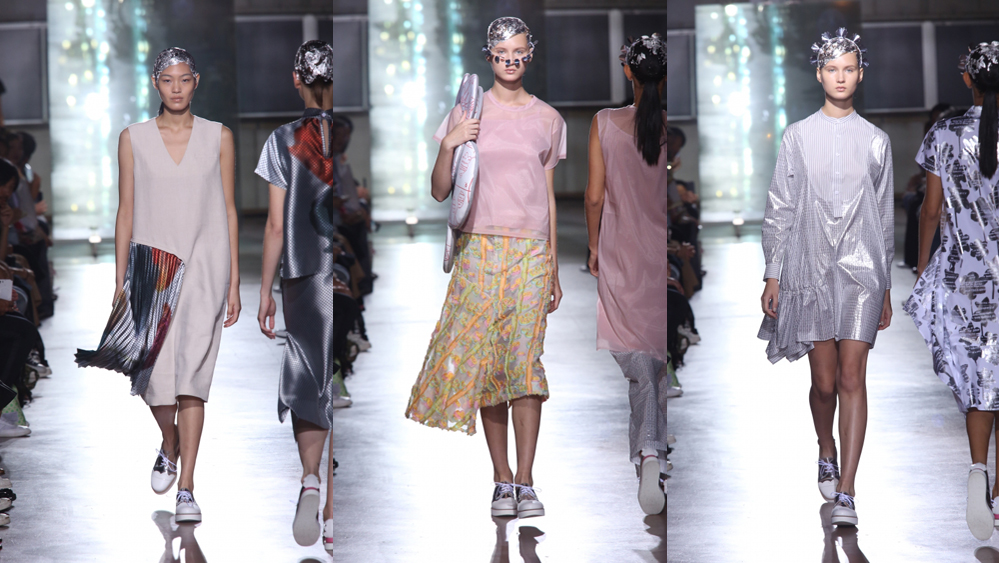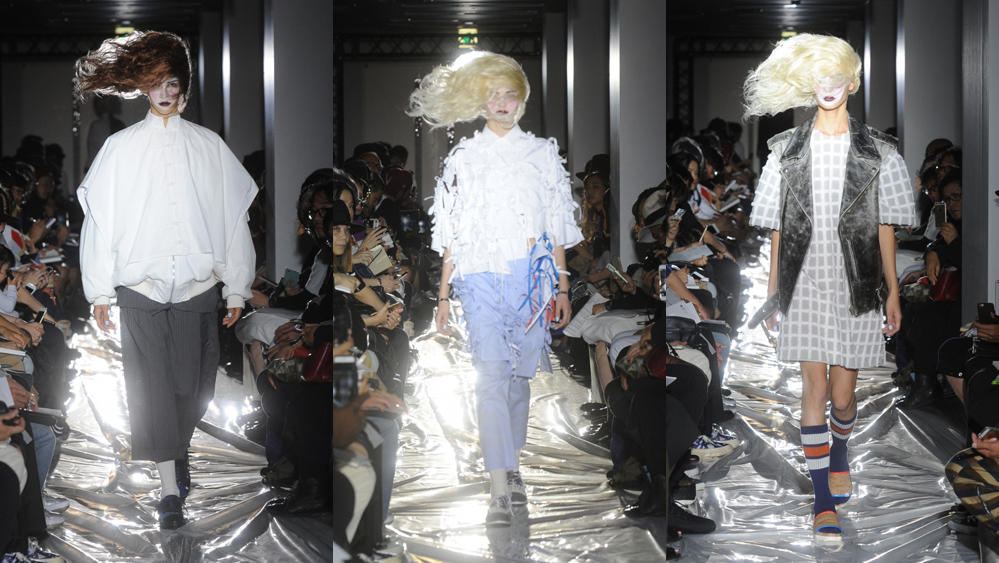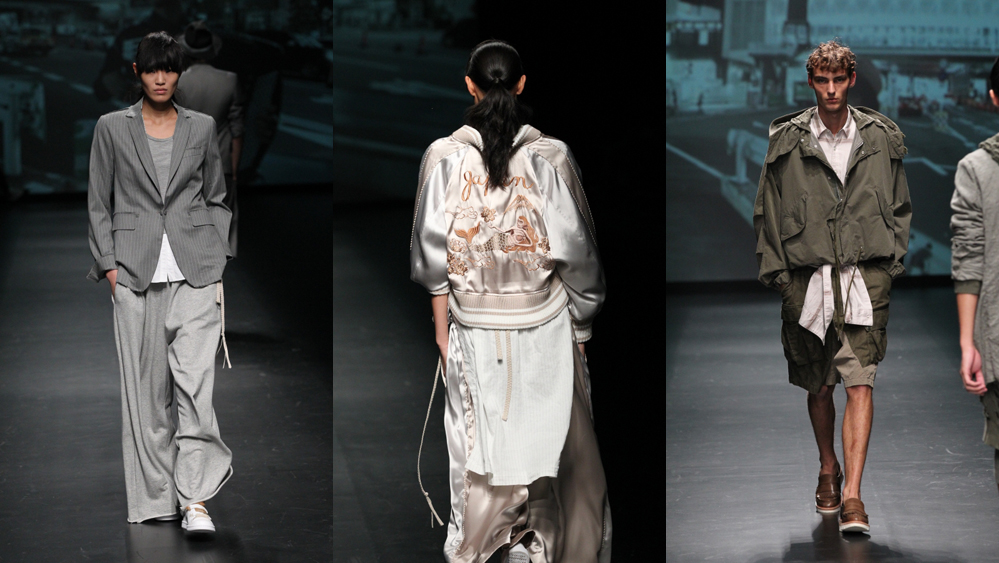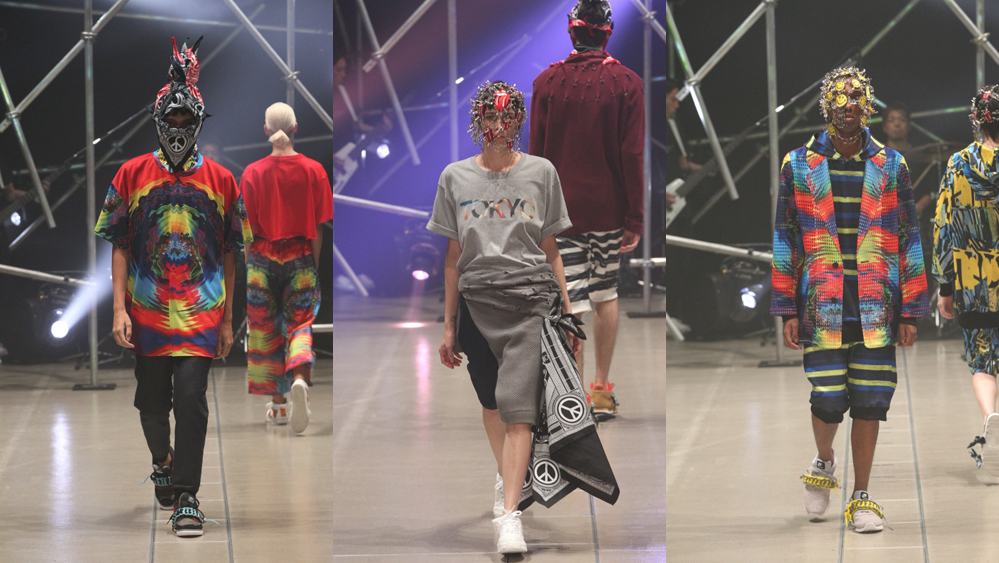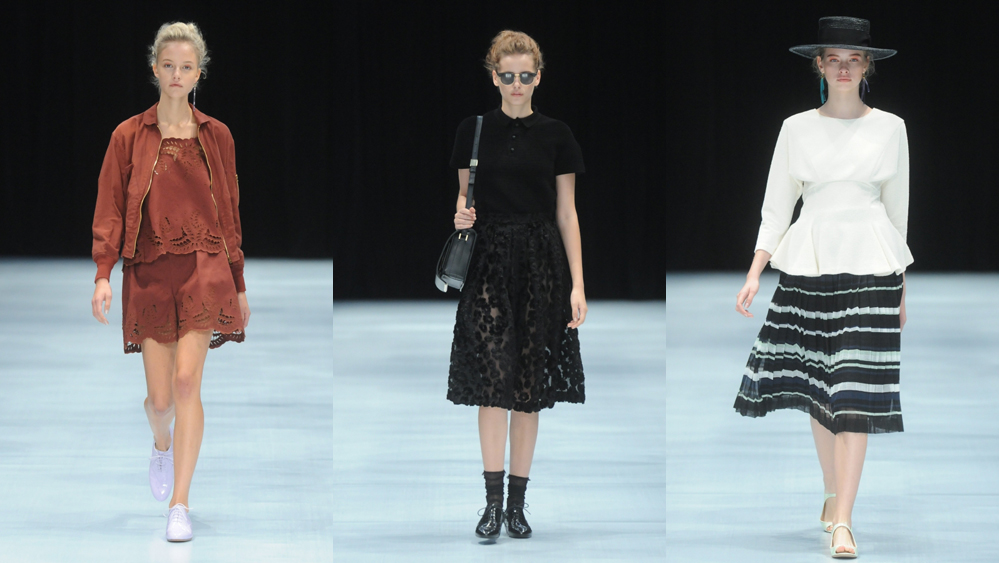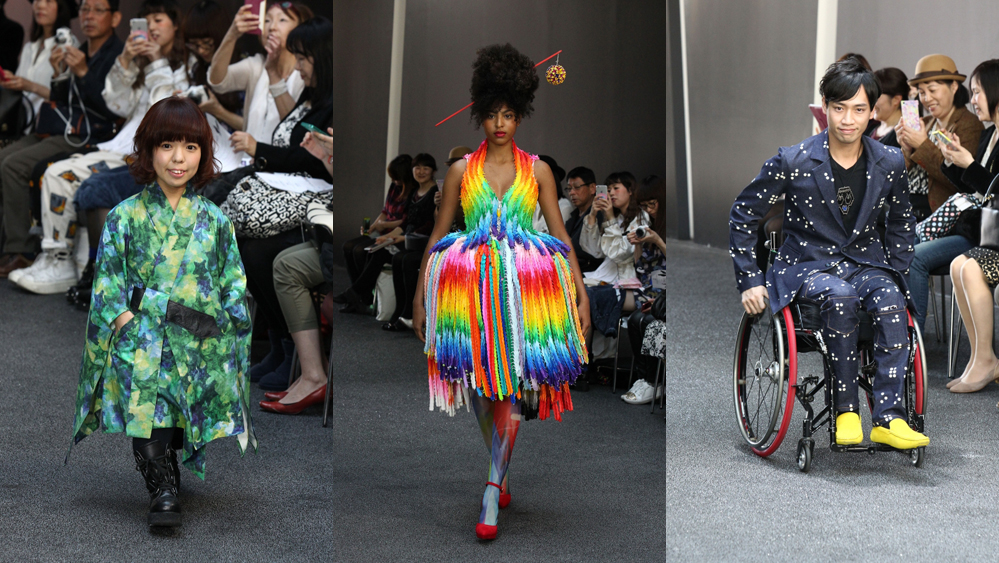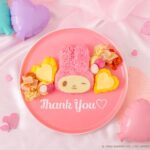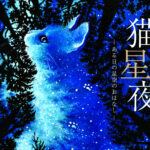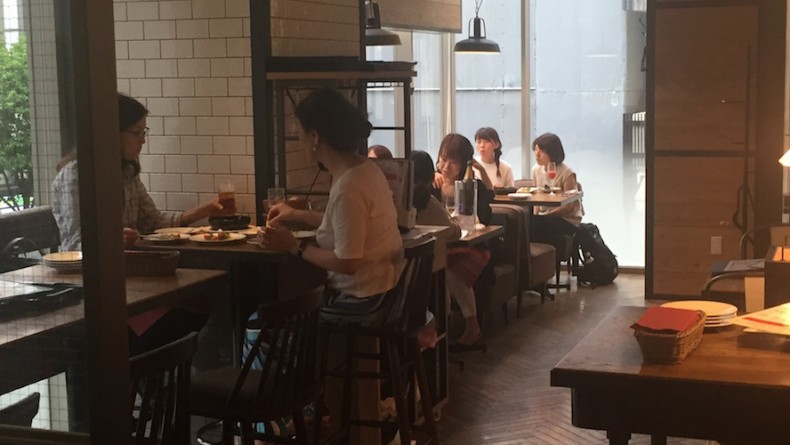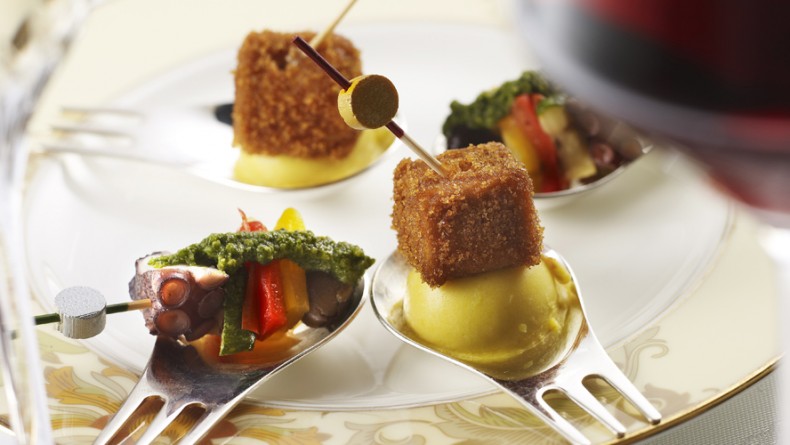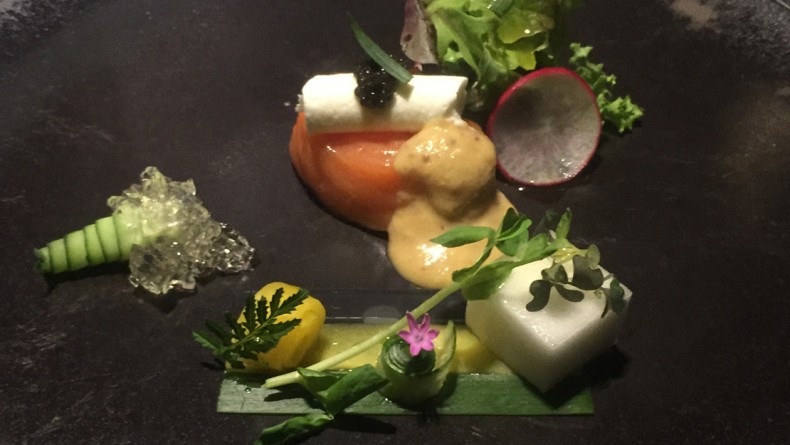Tokyo Fashion Week Spring 2016: Part 1
After opening with a show by New York-based menswear designer Todd Snyder, the spring season of Tokyo fashion week was off. From elegant lace dresses to edgy streetwear and even some clothes designed specifically for the physically handicapped, the first two days off the week literally had something for everyone. Read on for our recap below.
Mint Designs
Full marks. Mint Designs’ consistently clever, coherent collections are a joy to watch. The clever Central Saint Martins duo treated audiences to more of their divinely feminine, uber contemporary stylings, and succeeded in wiping the fear of Tokyo’s grizzly winter from the forefront of this author’s mind (at least momentarily). While highly styled, there’s an effortlessness to Nao Yagi and Hokuto Katsui’s work. Floaty floral pastel prints were kept grounded by stark black and moody grey tailoring, and finished off with trainers. Never ones to ignore headwear, the collection featured silver foiled coronets adorned with foliage-like designs. It was great to see some children’s wear incorporated so seamlessly into the collection as well. The padded 3D tote bag is one piece I’ll be flirting with come spring. –Juliette Olah
Facetasm
An electric vibe swirled about the narrow top floor of the Cultural Centre Owada (which also houses a planetarium), the Tokyo night sky glowing vibrantly in the background. The Facetasm audience was definitely an edgy set, and these guys wanted newness. Now.
For Bunka College graduate Hiromichi Ochiai, styling was a big win this time around. The wispy, asymmetric hairdos, heavily painted, doll-like makeup, and models who nonchalantly sauntered (as opposed to the usual aggressive strut) along the runway created a distinctly modern, inventive mood. It was a pleasure to watch, and created an understated, elegant kind of drama. The garments had a similarly dreamy feel, with stunning demonstrations of craftsmanship in stacks of knotted and pleated cotton layers, and the wildly exaggerated proportions of shirts and jackets. But Ochiai’s signature 90s grunge influence was still evident in the way of distressed leather and neon safety vests that topped the more floaty textures used this season. Overall, it was a wonderfully atmospheric, technically brilliant show with lots of heart and a highly devoted fan set. Utterly memorable. –Juliette Olah
Mihara Yasuhiro
Japan native and Tama University graduate Yasuhiro Mihara has become an internationally known designer. Most notable for his high attention to detail, Mihara first began his career as a shoe designer before launching his namesake label in 1996.
Mihara’ spring collection featured a medley of indigo denim trousers, overcoats and patchwork jeans, as well as mesh knits, safari jackets, and overalls in earth tone colorways. Fabrication and styling were a focal point on the catwalk, as mixed layering and a play with hemlines accentuated the fusion of denim, linen, cotton and silk used in the collection. Men’s shirts in exaggerated lengths were styled under mesh sweaters and topped with a drawstring jacket. Silk blend blazers were paired with loose trousers, marrying an office and athletic vibe. A highlight piece was the a silk bomber jacket with Japanese motifs embroidered across the back. –Chanyn Kirtman
Plastic Tokyo
Plastic Tokyo is a fresh face to the Tokyo Fashion Week scene. It was just launched in 2012 by designer Keisuke Imazaki, who seems determined to translate Japanese youth culture into clothing for the world to recognize.
The Plastic Tokyo runway show commenced with a live concert, complete with saxophone solos, strobe lights and electric guitars. Models walked to the contemporary jazz cadence in oversized t-shirts, blazers and wide legged trousers splashed with psychedelic prints. A contagious energy leaked out of bright patterns, which were reminiscent of swirl paint. The styling often referenced multiple eras. Iconic 1970s smiley face patches were connected by safety pins to create a veil, which was paired with a futuristic neon striped hoodie, shorts and rainbow colored blazer. Bandanas accessorized most looks, knotted into headpieces, bunched into capes, or accessorizing shoes. But apart from the abstract prints and textured fabrications, the silhouettes and designs of the clothing were pretty basic patterns. –Chanyn Kirtman
Beautiful People
With stores in Omotesando and Isetan Shinjuku, Japanese brand Beautiful People is a popular choice among well-dressed Tokyoites. Designer Hidenori Kumakiri launched the label in 2007, with the aim of helping women to feel confident.
Kumakiri’s latest offering exuded ladylike sophistication. The pastel and earth-tone colors magnified the luxe materials, including lace, woven cotton, and sheer chiffon with velvet-like floral embroidery. Peplum tops appeared in abundance, paired with ankle trousers or full, pleated midi-skirts. Jumpsuits and long dresses with asymmetric hems looked chic and modern, while a color series of rich auburn hues stood out amongst the lighter palette shown throughout the rest of the show. –Chanyn Kirtman
Tenbo
Tenbo’s signature departure from anything traditional by fashion week standards is provocative and certainly elicits an emotional response. As a designer myself, I tend to focus primarily on the art and technical skill of the designs put before me. Not much else usually grabs my attention. However, that kind of narrow-mindedness is not exactly possible when seated at a Tenbo show. This is a damn political statement, and designer Takafumi Tsuruta demands you sit up and listen (please).
The show had a narrative structure hinging around the horrific destruction of 1945, and opened with dooming monochromatic video imagery of a nuclear explosion. Models, many of whom were disabled, seemed to enact distinct characters, interacting with the audience and adopting different personas. The garments had only very tenuous links to each other, standing alone more as costumes rather than united as a collection.
Tsuruta functions as a designer to provide inclusive fashion, open and accepting to all—an important and beautifully moving platform from which to create. However, sadly, it seemed that the garments were overshadowed by the theatrics of the show. Yet there was one creation that had every phone in the studio snapping double-time. An incredibly joyful rainbow dress made of thousands of paper cranes obtained from a memorial monument at Hiroshima Memorial Park, complete with matching printed knee socks. Wow.
And with that, Tsuruta ended his story with exalted peace and hope. A stirring performance. –Juliette Olah

